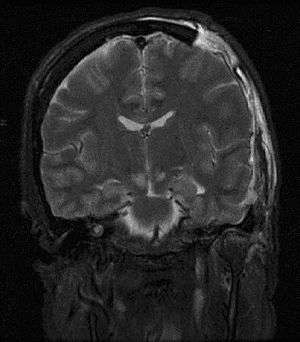Pressure reactivity index

Pressure reactivity index or PRx is tool for monitoring patients who have raised intracranial pressure (ICP), caused by pathologies such as a traumatic brain injury or subarachnoid haemorrhage, in order to guide therapy to protect the brain from damagingly high or low cerebral blood flow. Its application is in the setting of intensive care. PRx uses mathematical algorithms to calculate the correlation between arterial blood pressure and intracranial pressure. PRx assesses for correlations at low frequencies, below 0.5 Hz, and thus ignores individual pulses while capturing the effects of respiratory-driven variation in arterial pressure as well as other longer-acting stimuli. Under normal conditions, cerebral autoregulation ensures that changes in blood pressure are compensated for by vasodilation or vasoconstriction of the cerebral arteries; intracranial pressure should be unaffected by typical alterations in systemic blood pressure. However, in disease states following brain injury, this ability is partially lost and the intracranial pressure is more frequently influenced by the blood pressure.[1][2][3]
A high PRx has been found to be associated with poorer outcomes.[1][3][4] This may be seen at both lower than optimal and higher than optimal systemic blood pressures. When it is seen with low blood pressure this corresponds to passive collapse of cerebral arteries due to inadequate flow. When it is seen at high blood pressures this corresponds to forced vasodilation which overcomes the smooth muscle tone in cerebral arteries. In both cases there may theoretically be a therapeutic benefit to correcting the pressure to reduce the PRx. This could include increasing or decreasing the rate of inotropes if these medicines are in use. It might also include surgical intervention such as decompressive craniectomy. At present PRx is regarded as a research tool and has it has yet to be established whether treating patients to optimise their PRx improves their outcome.[4][5]
See Also
References
- 1 2 Donnelly J, Czosnyka M, Adams H, Robba C, Steiner LA, Cardim D. Pressure Reactivity-Based Optimal Cerebral Perfusion Pressure in a Traumatic Brain Injury Cohort. Acta Neurochir Suppl. 2018 ;126:209-212. PMID 29492563
- ↑ Czosnyka M, Czosnyka Z, Smielewski P. Pressure reactivity index: journey through the past 20 years. Acta Neurochir (Wien). 2017 Nov;159(11):2063-2065. PMID 28849287
- 1 2 Lang EW, Kasprowicz M, Smielewski P, Santos E, Pickard J, Czosnyka M. Short pressure reactivity index versus long pressure reactivity index in the management of traumatic brain injury. J Neurosurg. 2015 Mar;122(3):588-94. PMID 25423266
- 1 2 Copplestone S, Welbourne J. A narrative review of the clinical application of pressure reactiviy indices in the neurocritical care unit. Br J Neurosurg. 2018 Feb;32(1):4-12. PMID 29298527
- ↑ Moreira M, Fernandes D, Pereira E, Monteiro E, Pascoa R, Dias C. Is There a Relationship Between Optimal Cerebral Perfusion Pressure-Guided Management and PaO2/FiO2 Ratio After Severe Traumatic Brain Injury? Acta Neurochir Suppl. 2018;126:59-62. PMID 29492533